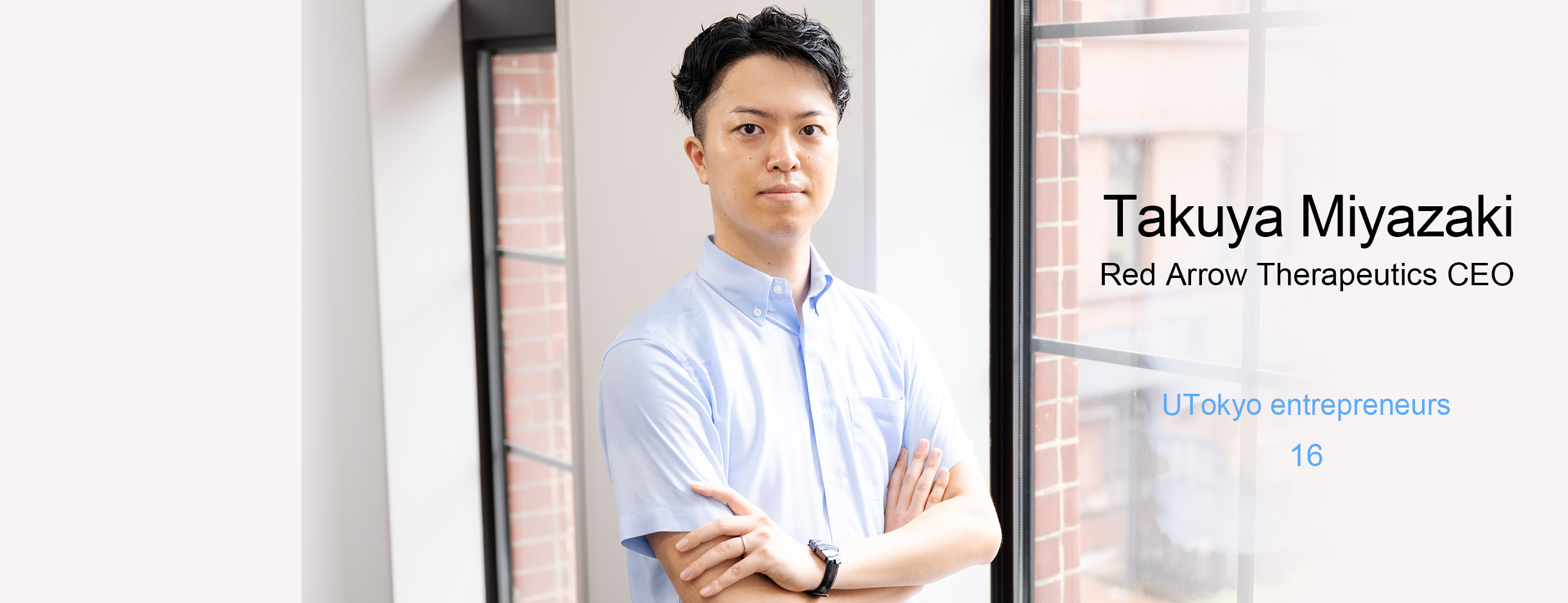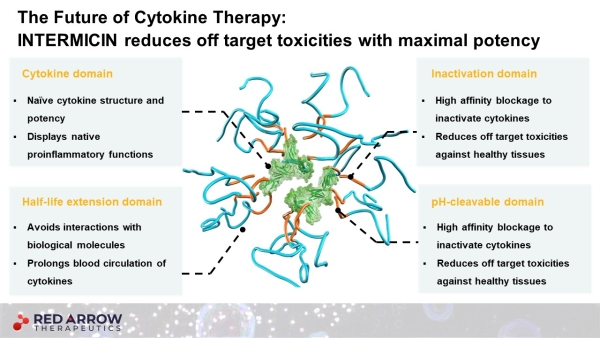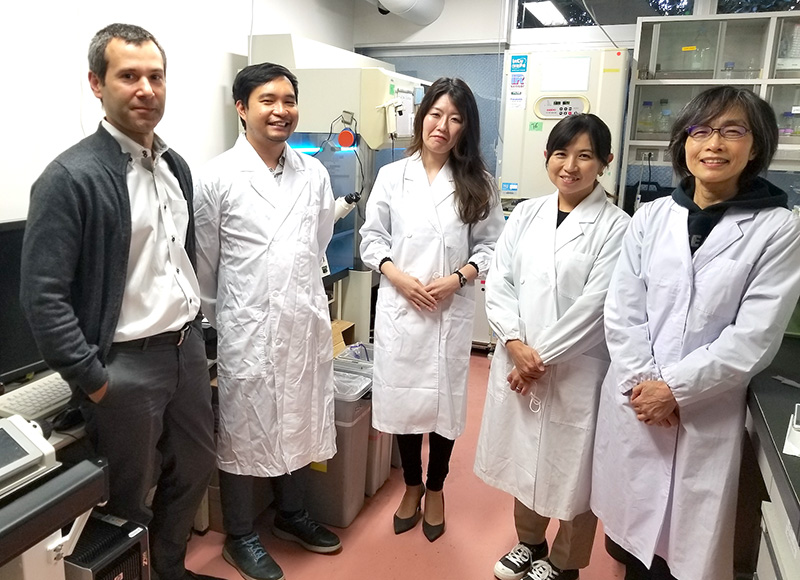Biotech startup delivers drug carrier targeting disease with precision Entrepreneurs 16

This series introduces entrepreneurs who have received startup support from UTokyo programs or who have utilized university research. UTokyo’s support aims to expand Japan’s innovation ecosystem.

While working with medical doctors at the University of Tokyo Hospital when he was still a master’s student at UTokyo, Takuya Miyazaki developed his aspiration to help save patients suffering from intractable diseases.
“One of the doctors told me, ‘Conducting basic research is important, but we also need to deliver research results that help patients who are suffering here and now,’” Miyazaki recalled. This comment sparked his desire to work to benefit society at large.
This sense of mission eventually led him to establish Red Arrow Therapeutics Inc. in August 2021. His startup, which has already procured 100 million yen (about $730,000 at the current rate) through Japanese government research and development grants and from venture capital firm University of Tokyo Edge Capital Partners Co., Ltd. (UTEC), has developed a drug delivery system to carry proteins that are effective in treating cancer and other hard-to-cure diseases, but are toxic when administered without a carrier.
The system can deliver proteins to diseased parts of the body with precision and is based on Associate Professor Horacio Cabral’s research findings. Cabral was Miyazaki’s adviser when the entrepreneur was working on his doctorate at the Graduate School of Engineering’s Department of Bioengineering.
Red Arrow Therapeutics is conducting experiments using mice to establish the drug delivery system’s effectiveness, a precursor to conducting clinical tests. If successful, Miyazaki intends to enter the global drug discovery market, through which he hopes to expand the company’s research and business network around the world to bridge science and society.
Entrepreneurship encouraged by mentors, members of society
About 100,000 kinds of proteins are said to exist in the human body. Many are effective as medicine for treating intractable diseases, but can be highly toxic, sometimes harming organs, such as the liver, that are healthy. Consequently, only about 200 proteins are available as therapeutics today, according to Miyazaki.
Miyazaki came across research on delivering such proteins when he joined Cabral’s group after completing his master’s degree at the Graduate School of Engineering’s Materials Engineering Department. His former lab, where he researched polymers and other materials, was one of several led by now Emeritus Professor Kazunori Kataoka, a globally renowned authority on drug delivery systems based on nanomachines, a mechanical or electronic device whose parts are single atoms or molecules.
After Kataoka retired, Miyazaki shifted the focus of his doctoral research to bioengineering, which fuses life science and engineering. His interactions with the UTokyo hospital doctors influenced this decision. He joined the group led by Cabral, who had succeeded one of Kataoka’s labs.
This new working environment made Miyazaki acutely aware of differences that exist between Japan and other countries, in terms of culture, language and even attitudes toward science. He also learned firsthand the gap between research and clinical practice.
“I developed the notion that I might be able to bridge these differences,” he said, adding that he began to consider entrepreneurship as a career option.
He then spent two and a half years at another university as a postdoctoral researcher, during which he contemplated whether he should pursue an academic career or become an entrepreneur. UTokyo’s Edge-Next program, which offers a class on the application of research outcomes to benefit society, nudged him toward entrepreneurship, Miyazaki recalled.
He took up this program during his first year as a postdoctoral researcher. Miyazaki was urged to become an entrepreneur by mentors from the program sponsor, UTokyo’s Division of University Corporate Relations, and businesspeople participating in the program.
“My eagerness and enthusiastic participation in the program caught the attention of people in the incubation ecosystem who strongly urged me to start a business,” he said. “Behind their insistence, of course, was the science developed by Professors Kataoka and Cabral.”
Delivering proteins is a daunting challenge

Proteins are mainly used as an active ingredient in producing antibody drugs and other biopharmaceuticals. A protein’s size is about 10 nanometers, which is several times larger than small molecules used for medicine. They also have more complicated structures and tend to break down before reaching the affected area. If proteins reach areas inside our body, such as the liver, that are healthy, they can trigger strong side effects.
Red Arrow Therapeutics’ drug delivery system centers around the use of a prodrug — a biologically inactive compound that can be metabolized in the body to produce an active drug — in which a protein is encased in a tiny particle known as a polymer micelle that serves as a carrier, to ensure the protein will not break down before reaching the targeted area.
The startup aims to use a prodrug it developed to treat solid tumors, including lung, breast and kidney cancers, in addition to metastatic cancers that originate in melanoma. It also is working to establish a therapeutic technology that would treat hypertension in pregnant women without the medicine reaching the placenta, thus protecting the fetus from the medicine’s effects.
This technology can be applied to any proteins that are effective as therapeutics. Miyazaki hopes his company’s prodrugs will be able to completely cure intractable cancers and autoimmune diseases, for which effective treatments have yet to be found.
Looking beyond borders with an international team
Red Arrow Therapeutics has adopted a rare employment approach for a Japanese startup. It has about 10 part-time staff members in Japan, Argentina, Brazil, Indonesia, the Philippines and the United States, who conduct research and development in their respective countries. Miyazaki manages projects by giving instructions to his staffers around the world, like an orchestra conductor overseeing and directing the musicians, to achieve a particular outcome.
While these workers may be engaged in the project part-time, they are professionals in conducting research and development in drug discovery. “I want to obtain approval for our prodrug in the United States and then fuse Japan’s technology with U.S. business,” Miyazaki said. “When our technology is combined with other pharmaceutical technologies and enters the drug discovery industry, it will be our most brilliant moment.”

Red Arrow Therapeutics Inc.
Established by CEO Takuya Miyazaki in 2021. As a master’s student, Miyazaki was affiliated with a laboratory led by now Emeritus Professor Kazunori Kataoka, who developed drug delivery systems by applying nanomachine technologies and whose labs have produced many entrepreneurs. Associate Professor Horacio Cabral, who succeeded one of Kataoka’s labs, which Miyazaki would go on to join, also researches nanoscale delivery systems. In order to focus on technologies related to their research, Miyazaki established the company with the aim of meeting calls to commercialize such technologies. The startup has procured 100 million yen from Japanese government grants and venture capital firm University of Tokyo Edge Capital Partners Co., Ltd. (UTEC) and plans to procure more funds in 2023. Backed by his international team of staffers, Miyazaki aims to acquire U.S. approval for the company’s prodrug. (Cabral is pictured at far left.)
Date of interview: Sept. 20, 2022
Interview/Text: Yumiko Mori
Top photo: Emiko Hara






